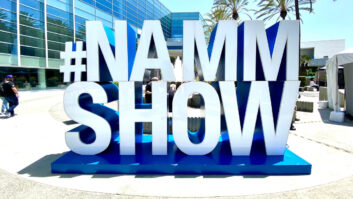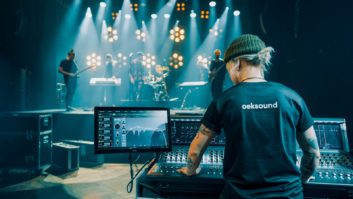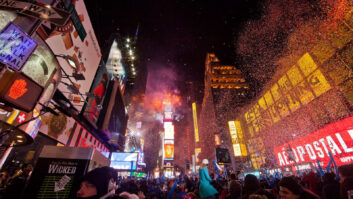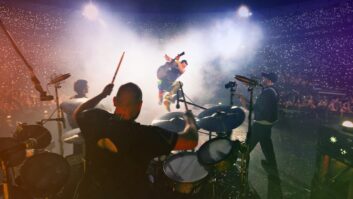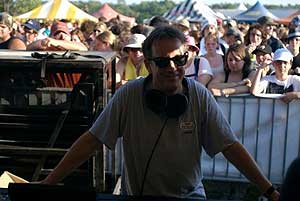
Pete Keppler
It was only a few years ago when we began to see live sound engineers carrying less outboard and relying more on onboard plug-ins. Today, an engineer not mixing with these onboard gems would be a rare find; this change may be the result of the gradual acceptance of digital consoles, which are now more of a mainstay on any tour. We checked in with a few FOH engineers to find out what’s in their “digital rack.”

Tom Young
Pete Keppler is currently mixing Katy Perry’s promo tour, working on whatever the venue puts in front of him—Mackie, Midas, Avid or Yamaha. “I’m using the SPL Transient Designer and EQ Rangers, Crane Song Phoenix and Avid Time Adjusters on guitars and drums, as well as the Aphex Big Bottom Pro and WavesLive R Bass [Renaissance Bass],” Keppler says, “the Serato comps and parametric EQ mostly on vocals, and the McDSP MC2000 on keys. The [McDSP FilterBank, other WavesLive and Avid plugs] get used on aux sends/effects returns and on desk outputs. I’m not carrying any outboard as this has been primarily a seven-month promo run, and with the flight/travel schedule, carrying anything outside of a USB stick, CF card and an iLok has been difficult logistically.” Keppler opted for these plugs primarily for sound quality, with ease of use and latency running a close second. In addition, he’s used all of these plugs in the studio and has been able to hear their colorations and impact on the signal in that environment. “I also use SoundToys plug-ins extensively in the studio. They make killer-sounding stuff, and I’ve been bugging them to get their software up and running on the major live console formats, but so far, no luck.”
Longtime Tony Bennett FOH engineer Tom Young mixes on a Yamaha PM5D-RH1, using a Waves Y96K card plugged into the fourth slot of the board. He employs Waves’ Renaissance package (which he’s also used for years on recording projects) for upright bass, guitar and vocals. “My show with Tony is very dynamic in nature, so I sometimes use the L2 limiter on the main P.A. and across the recording outputs,” Young adds.
Out mixing on a Midas Pro-6 with Rob Zombie is FOH engineer Joel Lonky, using such onboard plug-ins as Klark Teknik DN780 on vocals, DNS 780 on guitars and portions of the kit, dynamic compression on main vocals, and two long delays on the frontman. His thought process on choosing these plug-ins is pretty straightforward: “If it sounds good and does what I need it to do, I will use it,” he says.
Monitor engineer Richard “Dickie” Chappell mixes on an Avid Profile for Peter Gabriel and orchestra’s “The New Blood” tour in Europe and the States. “He spends the first-half of the show covering a bunch of artists, then he comes back on and sings a lot of his songs with orchestral arrangements,” he says. “There are no drums or guitars; it’s a new way for him to work.” As for plug-ins, “We have a long history working with the Sony Oxford team, which is now Sonnox. We still have an Oxford console, so the concern Peter has touring is that he really wants to be able to use the Sonnox plug-ins on the road. I particularly use the EQ for its amazing sound and analog feel. It’s very musical. Also, the Inflator and the Compressor got a lot of use; they are all pretty much essential.”
Are you using any interesting techniques with certain plug-ins?
Keppler: [Line 6] Echo Farm has a couple of patches with some modulation and saturation controls. When you set the delay time to “0” and fool with those controls, it’s great fun on vocals. Waves Imager and Shuffler can be really cool on some stereo inputs and delay returns, and I swear by the Renaissance De-Esser on bass, especially for thumb-slaps and super-saturated tones.
Lonky: I’m doing some side-chaining and effects-sending to other effects internally.

Joel Lonky
Do you find that you’re relying more on onboard plug-ins rather than carrying outboard gear?
Keppler: Yes. However, the one piece of outboard gear that I’ve come to love and rely on is the Dolby Lake Processor. To my ears it is still the best-sounding piece for system EQ and delay, and the interface is very intuitive.

Dickie Chappell
Young: Yes, most definitely. I’m averaging 100-plus shows a year with Tony, and most of the shows are fly dates in the U.S. or international. I can get a Yamaha PM5D everywhere—as I experienced this year in places like Istanbul, Turkey or Taormina, Italy. So being able to carry a Waves card or iLok key to get your plug-ins is very handy.
Chappell: I don’t carry outboard gear. I do wish I were though. But with time and speed as they are, Peter is a stickler for keeping things the same once they are established. He wants the Sonnox sound to be the same, and with the Profile I can bring back everything exactly as it was in the last show—brilliant.
Does the need for a smaller FOH footprint (to sell more seats, for example) come into play when deciding on bringing plug-ins vs. outboard gear?
Keppler: Not really—possibly in a festival situation where there are lots of desks at FOH and no room.
Young: In some venues, eliminating an outboard rack is definitely a big plus. However, my decision on not specifying an outboard rack is based on the end results. I can achieve everything I need to by using the internal processing with the Yamaha console and plug-ins.
Lonky: No, not really. We play arenas, and the console is so small it doesn’t really matter what I carry. My footprint is still half of what it was.
Do you find that your mix is more about replicating the album and using plug-ins used in the studio?
Keppler: I do get more requests these days to make it sound like “the album,” but often I have no clue what plug-ins were used in the recording and mixing process. If there is any time for pre-production rehearsals, I’ll take some time to really emulate certain sounds that I like from a record, like a particular distortion effect on drums or vocals, or a specific type of delay. And, obviously, if it’s something particular the artist is looking for, then I’ll work with them until we’re satisfied. I still prefer to make a live show just what it is—live!
Young: Not specifically for Tony Bennett, as the show is not designed around a lot of effects. The Waves plug-ins can enhance the whole experience by providing excellent-sounding reverbs and compression when required.
Lonky: Not at all. Rob wants a very live sound.
Chappell: Peter kind of throws that concept out the window—replicating the records. There is studio work, and there is live work. He’s now been comparing it recently to his film work and theatrical work. The live work is like theater and the studio work is film. The process of each is very different.
What are the advantages or disadvantages of using plug-ins vs. outboard gear for you? Is it an “either/ or” situation?
Keppler: To me, the analog outboard hardware versions have always sounded better than their digital virtual cousins for a variety of reasons. However, in a situation where you have so many inputs that need processing, it just becomes impractical to try and carry the racks and racks of outboard gear that could accomplish the task. That, coupled with the need for daily patching and resetting of outboard gear, usually make onboard plug-ins the winner for me. The only place I find outboard gear a better choice consistently is at the monitor position with IEMs, and for that, it really requires the use of an analog desk, as well. The latency factor of simple input-to-output patch on a digital console can have a drastic effect on the way an in-ear mix sounds and feels. Particularly for vocalists, the time delay between bone conduction and the sound arriving in their ears can seriously affect the coherency of their mix. And then if an engineer starts adding a few plug-ins that have some latency—you get the picture. I’ve noticed the difference with wedge mixes, too. At FOH, quite often you’re looking for a little system delay to line the P.A. up with the depth of the stage sound, and with the built-in latency of digital desks and their plug-ins, it’s not usually a problem that there’s some built-in delay. I find I may only need to add a few more milliseconds onto the system or sometimes none at all.
Young: I was always a big fan of Summit tube compression. The noise floor on some analog gear interfaced with a quiet show like mine makes it very noticeable when you switch to plug-ins and stay in the digital format. The noise floor becomes nonexistent.
Lonky: Actually, I use a combination of both plug-ins and outboard gear. I still use two Eventide H3500 DFX, a TC Electronic 2290 and an MXR GT-OD pedal.
Chappell: For live, no. It’s got to be immediate; you’ve got to be on it and it has to work right then and there. It’s a different attitude from recording, where you can spend time focusing on things. Live, it just happens fast and you have to be there for the artist. If you’re not, you have to get a different job.
What do you foresee in the future of plug-ins for live? Will there be a time when all an engineer needs is a card full of plug-ins and can pop his/her settings and the card into a console and mix away?
Keppler: I like your idea! It’s a bit like what I’ve been doing with the Avids: load my plug-ins and licenses into the desk and go. I am hoping to take the DiGiCo SD7 on my next tour, and I think I’ll be using some different plug-ins with that console than what I’ve been used to with the Avid desks. I am excited for that because the DiGiCo has the ability to use multiple screens and put the plug-in at the engineer’s fingertips on touchscreens—very cool!
Young: Plug-ins are a big part of the acceptance of the digital console format. With choices of studio-quality processors at your fingertips, the mixing engineer’s creative palette has limitless possibilities. I am a partner in a regional sound company, ACIR Professional in New Jersey, and can see a time in the near future where the ability to pick up a major sound system for a tour act could be rented locally to eliminate the need of trucking racks/stacks and consoles. If I can recall my sounds on a digital console with a Meyer, L-Acoustic, d&b, NEXO or JBL VerTec P.A. in any major city, the possibilities are limitless.
Lonky: I think we’ll see more and more plug-ins, but I think at some point we will reach a saturation point in the market and the companies will find their niches. It’s true that the plug-in industry has made it possible for small companies to compete with the “big boys” in regards to the market share. I think this will continue.
I use a USB stick that has all my show files; I have files for Zombie and some other of my other artists on it. I can go anywhere in the world, walk up to the console—this is dependent on getting the correct console—stick in the card, load it… bang: my entire last saved show, including all onboard plug-in settings and all other programming, is now at my fingertips in seconds. I have all my shows programmed into Midas, D-Show, Yamaha and a show or two in DiGiCo.
In the late ’80s and early ’90s, I would try all kinds of things to copy my board settings: tape, pictures with a Polaroid (ever tried to read console settings off one of those without a magnifying glass?), tape recorders, hand writing every setting and switch position on note paper. I embraced the whole digital thing as soon as it was a proven stable mixing platform. The ability to save everything has been a huge leap forward in itself. If you know the console mix is solid, then the save/recall ability allows you to do a small club all the way to a 40,000 to 50,000-seat festival without a soundcheck and not worry about the mix, as long as the P.A. is set up and tuned correctly. It has added tremendous consistency.
Any final thoughts on using plug-ins while mixing?
Keppler: Try mixing without ’em first. Mic choice, mic placement, proper balancing of keyboard patches and track levels from the stage are always better fixes than reaching for plug-ins. Given the list of plug-ins that I use, I guess that makes me a bit of a hypocrite.
Young: Plug-ins simplify your setup and give you more freedom when mixing with the ability to carry your sounds in your pocket. With presets and the ability to instantly recall your console settings and effects and EQ, the future seems very exciting for live sound mixing.
Lonky: Please don’t forget to mix using your main tools: your ears! Don’t get too carried away with a load of plug-ins on each channel. Less is more.
Chappell:With mixing live, you have to perform. You need to get on it and keep up with that performance coming from Peter and the band. It’s constantly changing, and it’s not just about recalling the presets and standing there. I jump on the faders and bounce around and get a vibe going. I wouldn’t be able to do the same thing years ago that I can now, purely because of the way the plug-ins work. Now give me some analog gear and I’ll certainly get along with it and use it. But I’m also talking about instant recallability of shows and presets that we use for Peter’s voice. It encourages performance and it encourages his reliability on me to make sure that I’ve got my act together to deliver each night.
Sarah Benzuly is the managing editor of
Mix.




